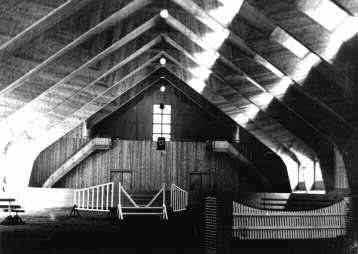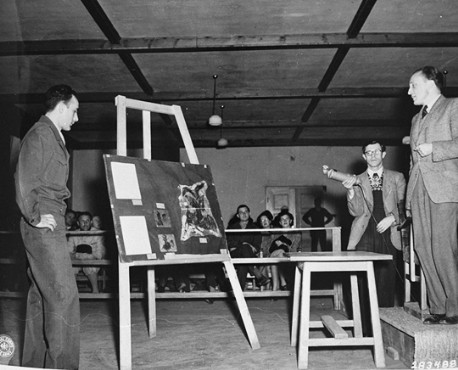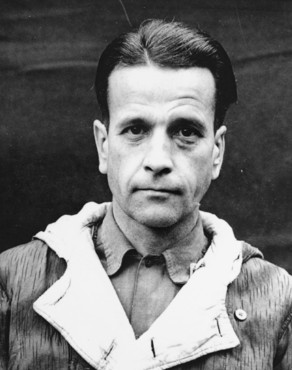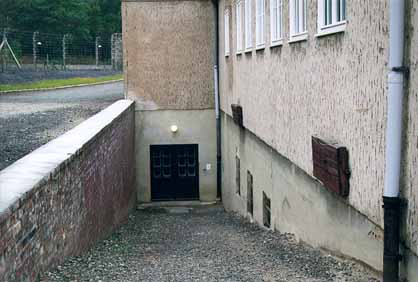Buchenwald Concentration Camp Atrocities Buchenwald is famous throughout the world for the lamp shades allegedly made from human skin which were found by the American liberators in the former home of Ilse Koch, the wife of the first Commandant, SS Col. Karl Otto Koch. Koch was the head of the camp from 1937 to 1941; he was then transferred to the Majdanek concentration camp in Lublin, Poland after charges of non-payment of taxes were brought against him by local authorities in Weimar. He was replaced by Hermann Pister, who was the Commandant when the camp was liberated. Ilse Koch was the second wife of Otto Koch. They had met and married in 1936 while Koch was the Commandant at the Sachsenhausen concentration camp and Ilse was a guard there. She was dubbed "the Bitch of Buchenwald" by the American press after the camp was liberated; the prisoners called her "Die Hexe von Buchenwald" (The Witch from Buchenwald). According to information at the camp Memorial Site and in the camp guidebook, Ilse selected prisoners with tattooed skin to be killed by her lover, Dr. Waldemar Hoven, in order to make leather lamp shades to decorate her home. An attractive redhead, Ilse was hated by the prisoners because of the provocative way she used to stroll through the camp, silently daring the prisoners to look at her. All the prisoners who came in contact with her had to address her as Gnädige Frau, a term of respect for a German lady. She had the reputation of being a hedonist who "took baths in Madeira (wine) that was poured into the bathtub," according to the Buchenwald Report. A prisoner who worked in the Koch home said in an interview for The Buchenwald Report that Ilse Koch was simultaneously having love affairs with Dr. Waldemar Hoven and with Deputy Commandant Hermann Florstedt. When Col. Koch was transferred to Majdanek, his wife stayed behind and was with Dr. Waldemar Hoven "almost all day," according to this prisoner who worked in her home.  In spite of the many atrocities alleged to have been committed in the concentration camps, the Nazis did not officially sanction cruelty to the prisoners. All punishments and executions had to be cleared with the main office in Oranienburg. An SS officer named Dr. Georg Konrad Morgen was put in charge of investigating cruelty and black market activities in the camps. Col. Koch had been engaging in both of these crimes, and he was eventually arrested in August 1943 for inciting the murder of two prisoners and for embezzlement. According to The Buchenwald Report, the murder charge against Col. Koch was based on the accusation that he had ordered the execution of hospital orderly Walter Krämer and his assistant, who had treated Koch for syphilis, so that they would not reveal his secret. According to the charges, Koch had falsely claimed that the two men were executed for political reasons. Ilse Koch and Dr. Hoven were also arrested by Morgen in August 1943 for mistreatment and murder of the prisoners. After a six-month investigation, Karl Otto Koch was condemned to death on both counts of murder and embezzlement, but his wife was acquitted of these charges. The charge of making lampshades from human skin had been withdrawn by Morgen for lack of evidence. According to The Buchenwald Report, one week before the American liberators arrived, Col. Koch was executed by the Nazis at the German Armament Works near the camp, thus saving them the trouble of putting him on trial. However, in a footnote in the book, Death Dealer, editor Steven Paskuly wrote that Koch "was shot in Buchenwald in September 1944." Ilse Koch's lover, Hermann Florstedt, was later transferred to Majdanek and became the Commandant there. He was also executed by the Nazis after he was convicted in the SS Court by Dr. Georg Konrad Morgen. Under their strict policies, the Nazis did not tolerate wanton cruelty to the concentration camp prisoners. Another camp commandant who was arrested for cruelty and corruption was SS Major Amon Göth, the commander of the Plaszow camp of Schindler's List fame; he was awaiting trial by the SS court when the war ended. After the war, Dr. Morgen was imprisoned in War Crimes Enclosure No. 1 at the former Dachau concentration camp to await trial as a war criminal. As a member of the SS, he was automatically a war criminal because the SS had been declared a criminal organization by the Allies after the war. Dr. Morgen was asked to sign an affidavit that his investigation had determined that Ilse Koch ordered lamp shades made from human skin, but he refused even after several beatings by the American interrogators, according to historian John Toland in his book entitled "Adolf Hitler."  Commandant Koch had an indoor arena built in 1940, where he and his wife, Ilse, could ride their horses. Located outside the camp, the riding hall was a 1600 square meters wooden structure covered with a steeply pitched slate roof. It was exclusively reserved for the use of the commandant and his wife. This caused great resentment in the camp and Ilse was severely criticized for the imperious way that she rode her horse around the arena. According to the camp guidebook, "Horses and a private riding hall were part of the status symbols the Camp Commandant Karl Koch surrounded himself with. His stately and lordly way of life was well-known in SS circles. He paid for it with money extorted from the prisoners and with large-scale embezzlement." The following quote is from Dr. Eugen Kogon, the author of "The Theory and Practice of Hell" which was a rewrite of the Buchenwald Report: Construction work had to be stepped up in such a way that about thirty prisoners suffered fatal injuries or were driven to death in the process. Building costs amounted to roughly a quarter of million Marks. Mrs. Koch made her morning rides in this place after its completion. This took a quarter or half an hour several times a week and had to be accompanied with music played by the SS band standing on a special platform. After Frau Koch was arrested and jailed in Weimar in 1943, the riding hall was used for storage. She was acquitted of all charges, but after the trial in Dr. Morgen's court, she did not return to her home in the Buchenwald camp. When the American liberators arrived, she had not been living in the Commandant's house for almost two years, but she had left the incriminating lamp shades behind.  In April 1947, Ilse Koch was brought before an American military tribunal in Dachau, where she was convicted and sentenced to life in prison. She was not convicted of ordering lamp shades to be made, but rather she was found guilty on a charge of participating in a "common plan" to violate the Laws and Usages of War under the Geneva Convention. During the review process, her sentence was reduced to time served, or four years, and she was released in 1949 by General Lucius D. Clay who said that the lamp shades in her home had been made from goat skin. Ilse Koch was then retried in a German court on charges of cruelty to the prisoners and ordering prisoners to be murdered. She was convicted again and sentenced again to life imprisonment; she committed suicide in prison in 1967. The German court did not charge her with making lamp shades, but the judges did take judicial notice that lamp shades, made from human skin, had been found in her home, although this had not been proved during the proceedings of the American Military Tribunal at Dachau. The photograph below shows a room in the pathology annex, which is called the Gedenkraum, or Place of Thought in English. A plaque on the wall of this room says that this is the room where the skin was flayed from dead prisoners to make lamp shades. No lamp shades, nor even a picture of them, are displayed anywhere in the Buchenwald Memorial Site. The Jewish newspaper Forward reported on April 4, 1997 that the National Archives in College Park, Maryland has identified "a human skin lampshade, or part of one," taken from the Buchenwald concentration camp and kept with government documents, and that the National Museum of Health and Medicine holds three pieces of tattooed human skin also taken from Buchenwald. Dr. Hoven was tried by the SS in Dr. Morgen's court, convicted and sentenced to death for murder. He spent 18 months in prison at Buchenwald, but was then reprieved because of the critical wartime shortage of doctors. He was prosecuted again by the Nuremberg International Tribunal in "The Doctor's Trial" and was executed in 1948 after being found guilty of killing prisoners. According to an official U.S. Army Report dated April 24, 1945, Dr. Hoven was an important Communist ally who killed numerous anti-Communist prisoners in Buchenwald with lethal injections.  According to an article entitled "Time 'Too Painful' to Remember" by Ari L. Goldman, published in the New York Times on November 10, 1988, Buchenwald survivor Morris Hubert was quoted as follows: In the camp there was a cage with a bear and an eagle. Every day, they would throw a Jew in there. The bear would tear him apart and the eagle would pick at his bones. The photo below shows the camp zoo where bears and other animals were kept. On the left side of the photo is one of the guard towers of the camp. The zoo was located just outside the camp and within view of the prisoners.  At Buchenwald, soap was made from animal fat, for the use of the camp inmates, in the basement of the Canteen. The door into the room where the soap was made is shown in the photo above. At the International Military Tribunal at Nuremberg in 1945, the Soviet Union charged that the Nazis had made soap from human fat. Soap that was allegedly made from human fat was displayed in the court room. The photo below shows the soap that was shown at the IMT.  At Nuremberg, the Constitution of the International Military Tribunal included the following: V. POWERS OF THE TRIBUNAL AND CONDUCT OF THE TRIAL [....] Article 21. The Tribunal shall not require proof of facts of common knowledge but shall take judicial notice thereof. The making of human soap by the Germans
was common knowledge that did not require any proof, so the Soviet
Union was not required to furnish a forensic report as evidence. Execution Room at BuchenwaldMedical Experiments at BuchenwaldExecution of Soviet POWsBuchenwald gas chamber?Back to Buchenwald index pageHomeThis page was last updated on March 1, 2008 |